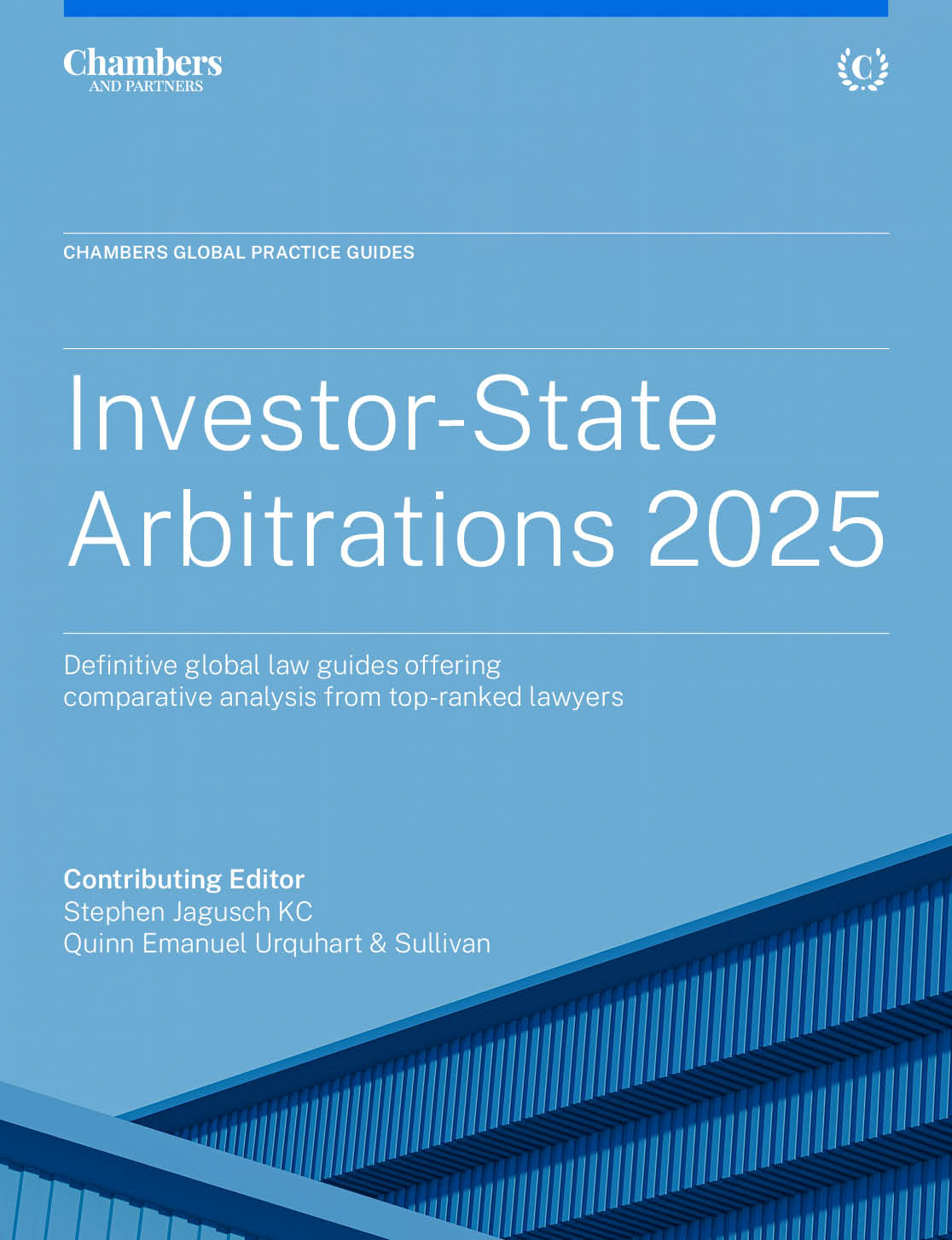
Investor–State Arbitration 2025
The new Investor–State Arbitration 2025 guide covers over a host of key jurisdictions and provides up-to-date legal insight into treaty-based and contract-based arbitration frameworks. It examines national positions on investor–state arbitration, key treaties and conventions, dispute resolution trends, third-party funding, damages and valuation, and the role of domestic courts in enforcement and interim relief.
Last Updated: October 22, 2025
Compare law and practice by selecting locations and topic(s)
Select Locations

Select Topic(s)

Please select at least one location and one topic to use the compare functionality.
Global Overview on Investor–State Dispute Settlement
Introduction
Investor–state dispute settlement (ISDS) has long stood as a cornerstone of international investment law, offering foreign investors a mechanism to challenge state conduct that interferes with investor rights. For decades, it has provided recourse to a largely neutral international dispute resolution mechanism, which mitigated the risk of investing in jurisdictions with perceived judicial or political uncertainty.
However, as the global investment and political landscape experiences tectonic shifts, ISDS has increasingly come under close legal and policy scrutiny. Concerns over regulatory chill, consistency in arbitral outcomes, and questions around legitimacy and transparency (among others) have spurred a wave of reform efforts, which vary from changes to arbitral procedure to the push for a multilateral investment court, and in some instances the outright abolishment of ISDS.
For investor–state dispute practitioners, this evolving terrain raises significant questions. How is the practice of ISDS adapting to new realities? How will this practice look in the next ten years? This overview explores the current trajectory of ISDS, considering the sustained criticism it faces, the steady rise of cases, and the potential pathways shaping its future development.
The backlash against ISDS and its consequences
In recent years, ISDS has been widely criticised by various stakeholders, particularly academics and civil society actors such as NGOs, as well as officials of several sovereign states or supra-national organisations, such as the European Union. Critics argue that ISDS undermines state sovereignty, prioritises corporate interests over public policy, and lacks consistency, transparency and accountability. The stated concerns also revolve around investment treaty protections affecting limitations on a state’s ability to regulate in the public interest, including public health, environmental and labour regulations.
Citing such concerns, several states across diverse geographies have chosen to phase out ISDS provisions in their investment treaties. In the case of the member states of the European Union, this was apparently done to protect and advance the supremacy of EU law in regulating investment. Several African countries, such as South Africa, Tanzania and Kenya, have selectively terminated investment treaties with European states. South Africa opted to enact domestic legislation that offers more limited protection of foreign investment. Other African countries have chosen a more region-specific route, adopting the African Continental Free Trade Area (AfCFTA) Investment Protocol as a substitute for “traditional” investment treaties.
Other states that have partly or wholly cancelled their investment treaties, such as Indonesia, Ecuador, Bolivia or Venezuela, justified their choice by referring to treaty obligations as having been imposed on them for the benefit of large foreign corporations, and to the detriment of their sovereign discretion over natural resources and investment-related policies. Perhaps ironically, while ISDS was created ostensibly to “de-politicise” disputes between foreign investors and sovereign states by creating an impartial forum for their resolution, the very existence of ISDS eventually became a political issue – and a hotly debated one.
Instead of outright eliminating ISDS, other states have chosen to modernise their investment treaties and to reform ISDS rules, reportedly aiming for a better balance between protecting investors’ rights and allowing states to regulate in the public interest, particularly in areas such as climate change and environmental protection, public health and human rights. Prominent examples of such “new generation” treaties include the Switzerland–Chile, EU–Chile and Singapore–Kenya bilateral investment treaties (BITs). This rebalancing leans in favour of increased sovereign discretion: according to data published by UNCTAD, nearly all newly drafted or revised investment treaties limit the scope of claims that can be brought under ISDS.
In parallel, state parties to ICSID and UNCITRAL have proposed procedural reforms to the rules governing ISDS to enhance efficiency and fairness, increase transparency, and ensure a more balanced approach in resolving disputes. ICSID adopted new rules in 2022 incorporating rules on expedited procedure, costs and provisional measures, amongst others. In 2023, UNCITRAL approved, inter alia, a Code of Conduct for Arbitrators and Judges, and Model Provisions on Mediation. Ongoing discussions in UNCITRAL’s Working Group III (which consists of representatives of the state members of UNCITRAL) are focusing on reforms in procedural arbitration rules, the establishment of a specialised investment court, and the creation of a centre for advising sovereign states involved in treaty disputes.
ISDS is still ascendant, but for how long?
Despite – or perhaps partly because of – the criticisms and legal and regulatory initiatives intended to limit ISDS, the number of ISDS cases continues to rise. Over the past ten years, during which time the backlash against ISDS has been strongest, the number of such cases has reportedly more than doubled. This increase can be attributed to several factors.
First, as foreign direct investment continues to grow globally, so does the potential for disputes and the recourse to ISDS. The proliferation of BITs over the past few decades has created an environment where investors can rely on ISDS mechanisms to settle disputes with host states. There are still around 2,000 BITs in effect around the world, with the majority containing ISDS provisions. It is trite to observe that investors can derive substantial value from the availability of ISDS remedies, especially when the relevant domestic court system lacks the resources or the expertise to handle disputes of great size and complexity.
Second, in recent years the political climate has reverted to regionalism and resource nationalism, which in turn has led to disputes over compensation for investments adversely affected by state actions, including outright expropriations. Several high-profile cases have brought attention to the ISDS system, most recently involving energy and national resources, with several states settling investment treaty disputes arising from expansive regulatory programmes or nationalisations in those areas. At the same time, the geopolitical uncertainty created by armed conflict, most prominently in Ukraine and in the Middle East, gives rise to new circumstances in which investment treaties can be deployed to protect valuable assets from state interference or direct taking, such as in the occupied territories of Crimea or Eastern Ukraine.
The future: a return to domestic courts?
It is reasonable to expect that the current political trend against multilateralism, combined with the ongoing efforts to limit the reach of ISDS, will have a profound impact on how international disputes are resolved in future.
As noted, one possibility is an agreement on a standing investment court. The ostensible goal of this permanent investment court is to improve the legitimacy, transparency and accountability of the ISDS system by creating a more “standardised” judicial process – one of the main criticisms against ISDS being that it takes place in various fora under ad hoc tribunals and varying procedural rules. The court is intended to consist of permanent judges selected through a presumably transparent and meritocratic process. The timing (or indeed the ultimate political feasibility) of the establishment of such a court is currently unknown.
Notably, in recent years mediation has been promoted as an alternative to arbitration in ISDS cases. Mediation could foster a more collaborative approach to resolving disputes, but so far it has not been widely adopted by either investors or states. The prospects of mediation-related initiatives in the ISDS space therefore remain uncertain.
The abolition of ISDS mechanisms in several jurisdictions could also imply a greater role for the local judiciary in resolving investor–state disputes, in addition to its current role of enforcing any resulting awards. In anticipation of this development, which inevitably means presenting local courts with complex, often politically significant matters with substantial stakes, states should be taking steps to ensure that local judicial systems are adequately funded and staffed, and to promote prompt access to, and administration of, justice. Improvement in domestic court systems would also motivate foreign investors and states alike to agree to the preservation of foreign investor protections in contractual agreements governed by domestic law – an approach that was also favoured before investment treaties became widely available.
Conclusion
Looking ahead, there is significant potential for a new model of ISDS that can address the concerns surrounding transparency, fairness and state sovereignty. Whether through adapted arbitration rules, the creation of a permanent multilateral court, the introduction of alternative dispute resolution mechanisms or the increased use of domestic courts, the future of ISDS will likely involve a mix of reform and adaptation, ensuring that it continues to offer investors protection, while respecting the regulatory autonomy of states and the public interest.

